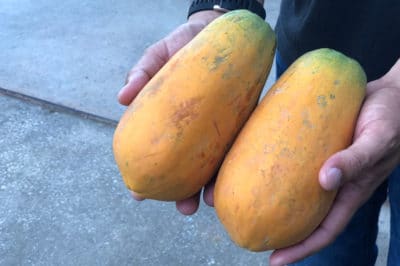About Papaya and Its Characteristics
Papaya resembles a tree, but it’s actually a giant plant that can grow 30 feet tall. Its native habitat is Central America but today, the world’s largest commercial papaya producer is Hawaii. Papaya fruit looks like a large melon and has a sweet flavor. Some people call this delicious, juicy fruit, paw-paw. The following list describes the characteristics of papaya:
- Hollow green or purple stems
- Grows from 6 to 10 feet in one year
- Long, stemmed leaves growing up to 3.5 feet long and 2 feet wide
- Short-stalked, white female flowers with five petals
- Male flowers on long panicles
- The developing flower determines the fruit size
- Fruit can weigh up to 20 pounds
- Fruit has thin, tough waxy skin
- Juicy, thick flesh is yellow, orange or red
- Center of fruit filled with black seeds
Papayas are rich in vitamins C and A, as well as calcium. You can prepare juice, jams, desserts and fruit salads with these nutritious fruits.
How to Know if Papayas Are Ripe
You harvest papayas when you see the first sign of yellow on the skin. However, this isn’t when the papaya is ripe. Whether you grow your own papaya, or you want to know how to select ripe papaya from the grocery store, the following tips can help you with your selection:
- Color – Check the color of your papaya. If you’re picking papaya, choose the green, hard ones. This eliminates bruising when you pick them and carry them in a container. If you’re buying papaya at the store, select the ones that have some green and yellow. Once you bring them home, you’ll ripen them at room temperature until they’re ready to eat.
- Examine stem – Take a look at the end of the papaya where the stem is located. If the ring is green, don’t pick it yet because it won’t ripen. If there is a yellow ring around the stem area, then your papaya will ripen after you pick it.
- Look at the skin – When selecting your papaya, check for any bruised or indented areas. Discard these papayas, if they’re in your yard and don’t select them from the store. Wrinkled skin is okay, and it won’t affect the flavor of the papaya.
- Press the skin – When you press your finger on the skin, it should be soft on a ripe papaya. You papaya isn’t ready to eat if the skin is still hard. Soft and mushy skin means that the fruit is overripe.
- Smell the fruit – If your papaya is ripe, it will smell sweet. Unripe papaya has no scent. On the other hand, a strong, overly sweet odor means your papaya is overripe.
How to Ripen Papayas on the Counter
Once you pick your papayas, or you’ve selected them from the sore, you can ripen them on the counter until they’re ready to eat. Make sure you keep them out of direct sunlight while they’re ripening. To make the ripening process quicker, you can place the papayas in a brown paper bag with fruits that produce ethylene, such as apples, avocados and bananas.
When your papayas are ripe, they’ll be fully yellow or red, depending on the variety, and soft to the touch. Once your papayas are ripe, they only last about three days when kept at room temperature. If you store them at about 50°F (10°C), they’ll keep for about 8 days, or you can store them in the refrigerator. Your best bet is to use them as soon as possible after they’re ripe.
